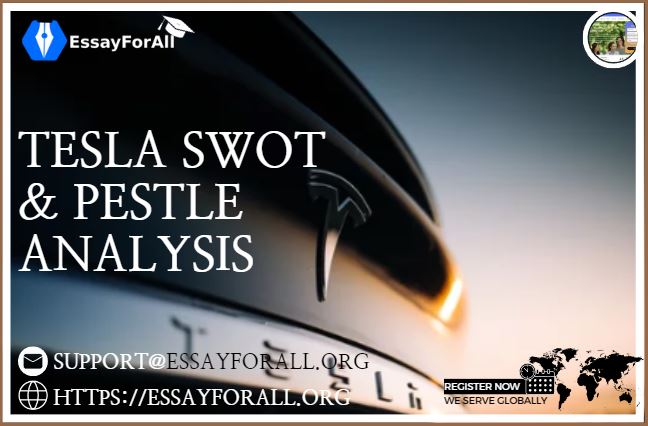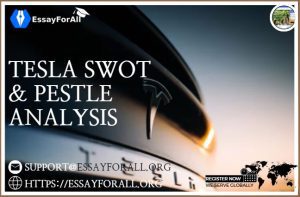Boost your Grades with us today!
Why Tesla SWOT & PESTLE Analysis?
Tesla SWOT & PESTLE Analysis evaluates the internal and external factors that affect the world-leading and disruptive company that manufactures electric vehicles. Through an ambitious business model, Tesla has diversified into solar energy and a battery that stores solar energy. They have also built a charging station network to allow electric vehicles to charge while on the go.
The company’s CEO and founder, Elon Musk, is a globally recognized entrepreneur. Through his innovative, sustainable and professional corporate strategies, he has revolutionized the automotive industry, thus making Tesla an interesting case study. This has not gone without critics and admirers in equal measure.
Tesla presents a real-world case that can provide insights to professionals and students willing to learn from a real innovative, sustainable business strategy thriving in a very competitive space. Tesla’s business model is faced with internal and external factors, which would be interesting to study. Analyzing SWOT (strengths, weaknesses, opportunities, and threats) and PESTLE (political, economic, social-cultural, technological, legal and environmental) factors Will provide a logical understanding of the business and guide diversification and strategic decision-making processes.
Tesla Company overview
Tesla employs a sustainable model that incorporates clean energy and manufactures electric automobiles. It was founded in 2003 by a group of professional business morgues Elon Musk, Martin Eberhard, Ian Wright, JB Straubel and Mark Tarpenning. It has its headquarters in Palo, California and employs over 120,000 people with its subsidiaries.
Tesla, Inc. is a most recognized company with its CEO Elon Musk as a co-founder. His leadership has catapulted the company’s growth and successes to the high levels it’s currently enjoying.
Tesla is the most recognized automobile company listed on the NASDAQ stock exchange, trading under the ticker symbol ‘ TSLA’ with a market capitalization approximated at $613 billion as of March 2023. In 2022 the automaker generated around $ 81.5 billion in revenue, a 51% increase from $51.6 in the previous year and a 70.67% registered increase in 2021. Through the sale of electric automobiles and energy storage products, Tesla registered annual revenues of $31.53B in 2020.
Tesla prides itself in making sustainable energy electric vehicles and clean energy solutions. Its expansive and innovative products include popular electric automobile brands like Model X, Model S, Model Y and Model 3. The company also offers solar energy solutions for businesses and home use, including solar energy storage, panels and solar roofs.
Tesla Products & Services
Tesla focuses on offering sustainable energy and transportation products and services, which include:
- Electric automobiles: These are technologically advanced, high-performance, efficient, safe and long-range driving capability models that include; Model X, Model S, Model Y and Model 3.
- Energy storage: These are clean, renewable energy storage products offering solutions for solar energy generated by Tesla solar panels. They include brands like power pack and power wall.
- Solar panels and solar roofs: These products seamlessly integrate with energy storage solutions to provide homes or businesses with renewable solar energy and reduce over-reliance on fossil fuels.
- Charging stations network: These stations allow vehicle recharging while on the go. Tesla is also diversifying to destination chargers at restaurants and hotels for the convenience of Tesla electric vehicle owners.
The whole idea of this technological innovation by Tesla is to provide sustainable energy and transportation products that reduce the use of fossil fuels that are unsustainable in future.
Tesla Competitor Analysis
Below is Tesla’s competitive analysis:
- Traditional automobile manufacturers: This includes internationally reputed companies like Toyota, Ford and General Motors that are also expanding to manufacturing of electric vehicles emulating Tesla automobiles. They enjoy presence and distribution networks globally.
- Electric vehicle startups: These are upcoming electric vehicle manufacturers focusing on offering innovative features and designs to compete with Tesla. They include Lucid Motors, Fisker and Rivian
- Solar Energy Companies: They include Sunrun and Vivint companies which endeavor to offer solar energy solutions but may not match Tesla’s innovation and reputation.
- Battery Manufacturing companies: These are reputed brands, including LG, Samsung SDI, Chem and Panasonic, trying to match Tesla’s vertical integration and supply chain control. They take pride in traditional relationships with vehicle manufacturers.
Tesla enjoys a comparative advantage of incorporating the best technologies, innovations and sustainability in its business model, making them compete well with more recognized brands with global presence.
Tesla SWOT analysis
In order to remain competitive and sustain business profitability, it is imperative to analyze SWOT, which stands for strengths, weaknesses, opportunities, and threats that Tesla faces in daily operations. It is a crucial tool in Tesla SWOT & PESTLE analysis since it helps the company’s management make informed decisions that leverage strengths, address weaknesses, and capture opportunities and threats mitigation.
Below is Tesla’s SWOT analysis:
Strengths:
- Innovation and Technology: Tesla company focuses on the development of sustainable energy solutions which employ top-notch technology accompanied by advanced innovations in manufacturing their electric automobile and solar energy solutions.
- Strong Brand Image: The company has an undisputed reputation for quality services and best-performing products. This has boosted its brand image by being associated with innovation, luxury and sustainability.
- Experienced, Visionary Leadership: Tesla pride itself on having professional and visionary leadership offered by recognized entrepreneur Elon Musk, the company’s CEO.
- Vertical Integration: Tesla incorporates a business strategy that lowers costs by managing its entire supply and delivery chains hence offering quality products and services.
Weaknesses:
- Challenges in Production: In the past, Tesla experienced delays and quality control challenges in some of its products, negatively affecting its ability to scale up production.
- High Prices: Employment of advanced technology and innovation has led to Tesla’s products being highly-priced compared to their competitors.
- Single Market Dependence: Tesla company concentrates more on North America for sales making it vulnerable to US market conditions and economic changes.
- Limited Product Rang: Compared to other competitors, Tesla has fewer product ranges that may not appeal to some customers despite having a strong electric vehicle portfolio.
Opportunities:
- Expansion to New Markets: To reduce dependency on North American markets, Europe, Asia, and other emerging markets offer space for diversification and expansion.
- Increasing Demand for Electric Vehicles: Tesla can use its comparative advantage in its electric vehicle portfolio to capture a larger market share, increasing revenue.
- Energy storage market: With the increasing demand for renewable energy, Tesla company has the potential for growth in energy storage solutions.
- Autonomous Driving: Through the employment of advanced technology in autonomous driving capability, Tesla has revolutionized the electric automobile industry and is an additional revenue stream for the company.
Threats:
- Intense Competition: New entrants and traditional automakers pose strong competition in clean energy and electric vehicles threatening Tesla’s business.
- Regulatory Changes: Government policies and regulations on emissions and incentives given to electric vehicles may significantly affect Tesla’s business.
- Supply Chains Disruptions: A disruption in the company’s supply chains may impact product delivery and production ability.
- Economic Uncertainty: Market downturns and volatility may impact Tesla company sales and revenue volumes.
Tesla’s SWOT analysis has identified and highlighted the company’s strengths, weaknesses, opportunities, and threats. By understanding the challenges and opportunities in this evolving and dynamic industry, Tesla will remain a leading establishment in clean energy solutions and electric vehicles manufacturer by using identified and informed solutions from the SWOT analysis.
Tesla PESTLE analysis
The other crucial component of Tesla’s SWOT & PESTLE analysis is the PESTLE analysis. PESTLE analysis comprises external factors that impact business. It’s an acronym for Political, Economic, Social-cultural, Technological, Legal and Environmental factors that affect business operations, revenues and profitability. Below is Tesla’s PESTLE analysis:
Political factors:
- Government Support for Electric Vehicles: Globally, governments’ support for electric vehicles is increasing through tax incentives and subsidies. This offers an enormous opportunity for Tesla’s business to expand its market share hence increasing revenue
- Trade Policies: Trade policies and tariffs affecting operations costs and supply chains impact the profitability of Tesla Company. For example, cheap Chinese components.
- Environmental Regulations: Positive environmental regulations emissions related incentives for customers could increase the purchase of electric vehicles.
Economic factors:
- Global Economic Conditions: Demand for luxuries like electric vehicles decreases with decreased disposable income resulting from economic downturns and recessions.
- Currency Fluctuations: Unstable currency impacts production costs when operating in multiple markets. For example, Tesla’s revenues could be affected by a strong US dollar which can lead to increased costs of imported components
- Interest Rates: Changes in interest rates could affect Tesla’s customers looking for a financed vehicle which would turn expensive.
Sociocultural factors:
- Changing Attitudes towards Sustainability: Customers’ positive behaviors towards climate changes and sustainability concerns can lead to more uptake of Tesla’s solar energy solutions and electric vehicles.
- Demographic Shifts: Changes in population demographics impact sales. For example, a youthful population is more likely to purchase a luxury electric vehicle.
- Consumer Preferences: Changes in preferences on performance, luxury and technology impact on demand for various models. For example, increased preferences for the bigger automobile could increase the purchase of Model S and X of the Tesla brand.
Technological factors:
- Innovation in Electric Vehicle Technology: Competition for Electric vehicles is stiff with increased technological innovations. In this case, Tesla needs to invest its best to maintain its market share.
- Cyber security: Tesla’s brand reputation and customer trust can be hurt by cyber security threats since its business model relies highly on technology.
- Autonomous Driving: Autonomous driving technology requires huge investments since it will transform the automobile industry. Therefore, technological and regulatory adoption delays could pose a major challenge.
Legal factors:
- Intellectual Property Lawsuits: Tesla’s autonomous driving technology can be subjected to intellectual property lawsuits, affecting the ability to sell and develop this innovative product.
- Product Liability: Criticism and safety concerns on Tesla’s vehicles could significantly negatively impact Tesla’s brand, affecting sales.
- Labor Laws: Maintaining a company’s image and reputation is pivotal to survival in a competitive market. Compliance with labor regulations and avoidance of legal disputes is hence very critical.
Environmental factors:
- Access to Renewable Energy: Availability and accessibility of renewable energy sources, for example, wind and solar power, are key to the production and sale of Tesla’s products.
- Climate changes: Adopting clean energy solutions could positively impact Tesla’s sales. However, negative climate changes could pose environmental risks jeopardizing operations.
- Resources Scarcity: The availability of raw materials such as lithium used in battery manufacturing could cause strain on the product supply chain.
Therefore, in conclusion, PESTLE analysis can be used to evaluate external factors impacting Tesla’s business. Customer behaviors and government policies supporting clean energy solutions have a major contribution that could impact Tesla’s revenue volumes and profitability. Changes in resource availability and intellectual property suit are detrimental and hence posses a greater threat to Tesla’s company’s survival. Informed decisions from the analysis are vital in strategic decision-making processes on Tesla’s business model since it will assist in capitalizing on opportunities and threats mitigation.


